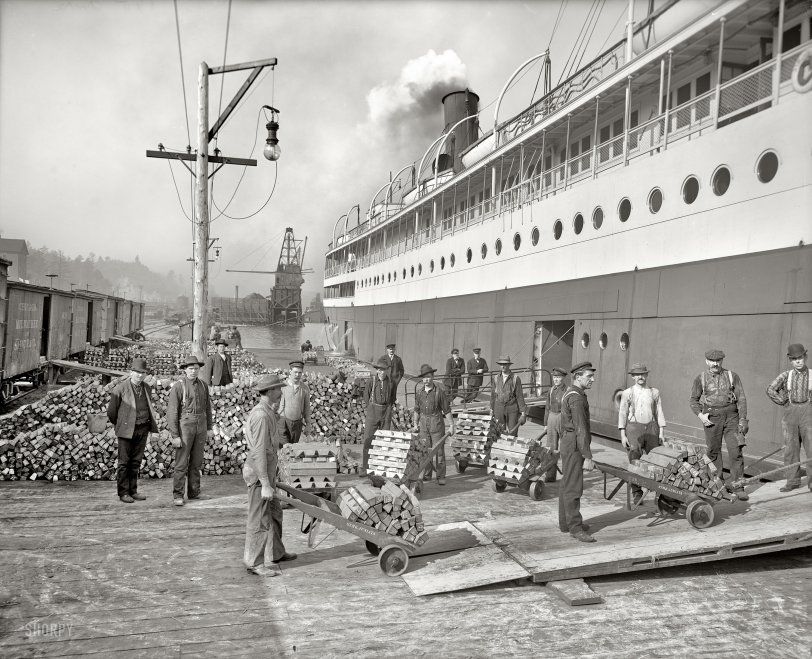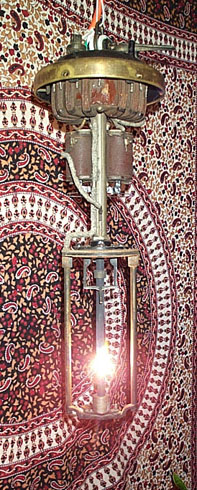


Framed or unframed, desk size to sofa size, printed by us in Arizona and Alabama since 2007. Explore now.
Shorpy is funded by you. Patreon contributors get an ad-free experience.
Learn more.

- What a headache!
- Baldwin 62303
- Baldwin VO-1000
- Cold
- No expense spared
- Tough Guys
- Lost in Toyland
- And without gloves
- If I were a blindfolded time traveler
- Smoke Consumer Also Cooks
- Oh that stove!
- Possibly still there?
- What?!?
- $100 Reward
- Freeze Frame
- Texas Flyer wanted
- Just a Year Too Soon
- WWII -- Replacing men with women at the railroad crossing.
- Yes, Icing
- You kids drive me nuts!
- NOT An Easy Job
- I wonder
- Just add window boxes
- Icing Platform?
- Indiana Harbor Belt abides
- Freezing haze
- Corrections (for those who care)
- C&NW at Nelson
- Fallen Flags
- A dangerous job made worse
Print Emporium
King Copper: 1905

Houghton, Michigan, circa 1905. "Loading copper on steamer Juniata." 8x10 inch dry plate glass negative, Detroit Publishing Company. View full size.
All things being equal
Those pig ingots are 15 pounders, The end slugs are two and a half pounds each and the two center 'Big Pigs' are five pounds each. Even so, at today's prices, there has to be over 500 dollars worth of copper on each barrow!
Awesome!
I've been through Houghton and in a few of the copper mines in Copper Harbor!
Arc Lamp
This has to be one of the best photos of an enclosed dual globe arc lamp in service that I have seen to date. The lamp pictured is a GE "interchangeable type" of about 1900-1906 production designed for parallel circuit service. Note the wood box on the pole which likely has a switch to turn the lamp on and off. This would be a low voltage (110) lamp, as a higher voltage lamp for series service could not be safely switched off.
An up-close view shows both the inner enclosing globe surrounding the carbon rods and the outer globe with removable brass collar and attached safety chain. The inner globe allowed the carbon rods to burn in an inert atmosphere, making changes of carbon rods less frequent. a typical lamp needed trimming only once a week under regular use.
These lamps were once very common but nearly all were destroyed in scrap drives for the two world wars. Operational examples are extremely rare.
The attached photo shows a still operational example of this exact lamp showing the clutch mechanism and current limiting inductance transformer above.
[Another interesting arc lamp here. -Dave]

The Effort Involved
The man wheeling a barrow from the far end of the ship demonstrates how much effort was needed to roll those loaded barrows before the rope was attached. They knew what they were doing: note how the peak of each pile of ingots is usually centered over the axle for balance when the wheeler picks up the handles and stands straight. The long handles on the barrows are needed for leverage to swing that massive load up into balance.
If that's copper, I wish that pile was mine, with today's prices.
Arc Sequel
By that time (1905) the arc lamp in all it forms had reached a rather 'mature' design state... the mechanisms to keep the carbons feeding properly (and the arc itself stable and consistent) were cleverly designed and well known for more than 50 years.
One still had to supply new carbons, as of course they were consumed in the process. So most of the reasons for suspending the lamps on pulleys was to enable replenishment without resorting to tall ladders on horse-drawn wagons or pole-climbing and cross-arm hanging.
Some info here: http://en.wikipedia.org/wiki/Arc_lamp
As side note, a friend has several WW-II era carbon-arc searchlights which he rents out for advertising; I have operated and maintained them for him, and further I have experience with commercial cinema and have at times been called to run a few carbon-arc projectors (now very rare) - those require some fancy choreography in the projection booth to keep things bright and the audience happy.
And on the manual labor issue - if those ingots weigh (conservatively) 30 pounds each, I count over 30 on the barrow in the foreground - that's nearly 1/2 ton loaded and pushed up to the start of the ramp and who knows where in the hold of the ship. Note the rope attached to the barrow on the ramp -- so at least they were using a winch to haul the loads up. But: how many of those trips did each man make in a day? Most of them don't even have gloves. Puts some perspective on what folks did to earn a living.
In 1970
I rode the Milwaukee Clipper from Milwaukee to Muskegon when I was 12. Once. The family and I had a nice lunch at Pieces of Eight, then my grandmother and I boarded the ship (with her car loaded aboard) for the trip across the lake for a family visit in Ann Arbor. The weather turned rough and the ship soon had that distinctive odor of vomit wafting through it. Wishing to be discreet, and despite the bad weather, I went topside and ralphed all over the upper deck.
Queen of the Great Lakes
Launched in 1904, the SS Juniata is still afloat as a maritime museum in Muskegon, Michigan. Renamed the SS Milwaukee Clipper, she was rebuilt twice before 1937. The ship museum's website details her long history at www.milwaukeeclipper.com

Still Around
Looks like she's still around. To summarize:
The Milwaukee Clipper, another passenger steamer. Built in 1904, she served as a passenger/package freighter for the Pennsylvania Railroad marine division called the Anchor Line as the Steamer Juniata. In 1940, after several years in layup, she was sold and converted to an excursion steamer between Muskegon & Milwaukee. Laid up in the 1970s, she lingered for 30 years before returning to Muskegon as a museum.
Doesn't look much like the photo anymore though.
Love It.
This is one hell of a good Photograph! Thank You.
Arc story
The carbon arc lamp is suspended on a cable and pulley system, with wiring long enough to reach the ground. The lights, while bright, required frequent adjustment.
Relative costs
Clearly, this was a time when machinery was expensive (if it existed) and labor was cheap.
Suspended in Time
Why did suspenders go the way of the buggy whip? We don't depend on horses as our main source of locomotion any longer, but men still have the need to keep their pants up.
As the reluctant owner of a 1950's vintage male body I find that suspenders are far superior than a belt in preventing my britches from suffering the cruel and embarassing effects of gravity.
























On Shorpy:
Today’s Top 5